Full metadata record
| DC Field | Value | Language |
|---|---|---|
| dc.contributor.advisor | Martinez-de-Tejada, G. (Guillermo) | - |
| dc.creator | Bárcena-Varela, S. (Sergio) | - |
| dc.date.accessioned | 2018-10-30T12:24:10Z | - |
| dc.date.available | 2018-10-30T12:24:10Z | - |
| dc.date.issued | 2018-10-30 | - |
| dc.date.submitted | 2018-06-12 | - |
| dc.identifier.citation | BÁRCENA, S. "Caracterización preclínica de Pep19-2.5 y Pep19-4LF, dos péptidos antimicrobianos en desarrollo para el tratamiento de la sepsis", Martínez, G. (dir). Tesis doctoral. Universidad de Navarra, Pamplona, 2018. | es_ES |
| dc.identifier.uri | https://hdl.handle.net/10171/55478 | - |
| dc.description.abstract | Sepsis is a severe pathology caused by a systemic and disproportionate pro-inflammatory response of the immune system to an infection. Frequently, sepsis worsens and results in endotoxic (or septic) shock, which is accompanied by multi-organ failure and is usually fatal in a large number of cases. Microbial molecules triggering the most potent immune system activation are lipopolysaccharide (LPS or endotoxin) and lipoproteins (LPT) of Gram-negative and Gram-positive bacteria, respectively. Currently, there is no specific therapy against sepsis. The only treatments available are limited to fluid replacement and other life support measures. Each year, sepsis affects approximately 800,000 people in the United States alone and it has been estimated that between 28 and 50% of those affected die. Our group designed an antimicrobial peptide called Aspidasept I® (Pep19-2.5) which has high affinity in vitro for LPS and for whole cells of Staphylococcus aureus and which is capable of protecting mice against endotoxic shock. We also developed Aspidasept II® (Pep19-4LF) which has a much more potent antimicrobial activity than Pep19-2.5. Our hypothesis is that either Pep19-2.5 or Pep19-4LF, by themselves or combined with antibiotics could be effective anti-sepsis therapies in humans. To advance in the preclinical development of these compounds we characterize selected in vitro and in vivo activities of them with emphasis in those properties related to their application for the treatment of sepsis. We demonstrated that Pep19-2.5: afforded protection to mice against a lethal dose of the pro-inflammatory lipoprotein FSL-1 and efficiently cooperated with ceftriaxone to counteract sepsis-associated symptoms in a rabbit model of acute bactaeremia. However, the significant toxicity of Pep19-2.5 along with its poor half-life in blood and its sensitivity to proteases led us to focus our efforts on the preclinical development of Pep19-4LF. Compared with Pep19-2.5, we demonstrated that Pep19-4LF: i, is much more potent as antimicrobial and has a broader spectrum of activity; ii, is more capable of enhancing antibiotics and sensitizing multi-resistant strains to those compounds; iii, has a significant anti-biofilm bactericidal activity against P. aeruginosa Ps4 alone and combined with levofloxacin; iv, retains its antibacterial activity when immobilized on a polymeric matrix and prevents growth of P. aeruginosa biofilm as efficiently as colistin. Interestingly, Pep19-2.5 and Pep19-4LF synergized with each other against multi-resistant strains and showed a comparable capacity to protect mice against a lethal endotoxic shock. These results suggest that Pep19-4LF holds promise as a candidate for human sepsis therapy. In its turn, Pep19-2.5 could be developed for the topical treatment of infected wounds, since this peptide showed wound healing activity in mice as high as the reference compound. | es_ES |
| dc.language.iso | spa | es_ES |
| dc.rights | info:eu-repo/semantics/openAccess | es_ES |
| dc.subject | Antibióticos | es_ES |
| dc.subject | Microbiología | es_ES |
| dc.subject | Inmunología | es_ES |
| dc.subject | Fisiología bacteriana | es_ES |
| dc.subject | Materias Investigacion::Ciencias de la vida::Biología | es_ES |
| dc.title | Caracterización preclínica de Pep19-2.5 y Pep19-4LF, dos péptidos antimicrobianos en desarrollo para el tratamiento de la sepsis | es_ES |
| dc.type | info:eu-repo/semantics/doctoralThesis | es_ES |
Files in This Item:
Statistics and impact
Items in Dadun are protected by copyright, with all rights reserved, unless otherwise indicated.






